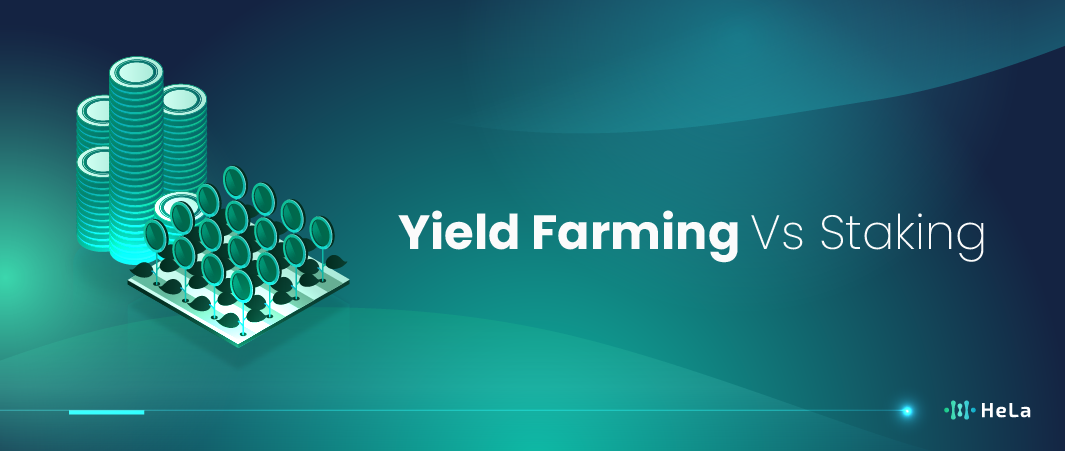In the ever-evolving world of blockchain and cryptocurrency, two investment strategies stand out for those looking to maximize their digital assets: yield farming and staking. These methods offer unique opportunities for investors to earn a return on their holdings, but they come with their own sets of risks and rewards. Understanding the nuances between yield farming and staking is crucial for anyone venturing into the blockchain investment space.
Yield farming, often associated with the decentralized finance (DeFi) sector, involves lending or staking cryptocurrency in exchange for interest or fees in return. It’s akin to earning interest in a traditional bank savings account but operates in the decentralized ecosystem of blockchain. Staking, on the other hand, is the process of actively participating in transaction validation on a proof-of-stake (PoS) blockchain. Both methods contribute to the liquidity and security of the blockchain network, yet their mechanics, risks, and potential returns vary significantly.
This article aims to provide a comprehensive comparative analysis of yield farming versus staking, tailored for blockchain investors. By breaking down their key differences, risks, and rewards, we aim to equip you with the knowledge to make informed decisions about which strategy might best suit your investment goals. Whether you’re a seasoned investor or new to the blockchain scene, understanding these concepts is essential in navigating the complexities of cryptocurrency investing.
What is Yield Farming?
Yield farming, a fundamental concept within the decentralized finance (DeFi) sector, represents an innovative method for cryptocurrency investors to generate returns on their holdings. Unlike traditional banking, where interest is earned on deposited funds, yield farming involves lending or staking cryptocurrency in exchange for rewards, typically in the form of additional tokens. This process leverages the burgeoning DeFi ecosystem, a network of blockchain-based financial services that operate without central authority, offering a range of services from loans and savings to trading and insurance, all executed via smart contracts.
Key Components of Yield Farming
- Liquidity Pools: At the heart of yield farming are liquidity pools, which are essentially pools of tokens locked in a smart contract. These pools facilitate the market’s liquidity, allowing for lending, borrowing, and trading of various tokens. When users add their tokens to these pools, they receive liquidity provider (LP) tokens in return, representing their share of the pool and entitling them to a portion of the transaction fees generated by the pool’s activity.
- Smart Contracts: Yield farming operates through smart contracts, which are self-executing contracts with the terms of the agreement directly written into code. These contracts automate the distribution of rewards and ensure that all transactions and interactions within the DeFi ecosystem are transparent and trustless.
- Rewards: Rewards in yield farming are often dynamic, influenced by several factors including the amount of liquidity a user provides, the duration of liquidity provision, and the overall demand for liquidity within the pool. Rewards are not limited to a single form; participants may earn interest, new tokens (often the native token of the protocol they are interacting with), or fees generated from the underlying DeFi services.
Also Read: Top 10 Blockchain Marketing Companies to Consider in 2024
- Risks: While yield farming can offer significant returns, it’s not without risk. The complexity and novelty of DeFi protocols mean there’s a higher risk of smart contract vulnerabilities. Additionally, the volatile nature of cryptocurrency prices can affect the value of deposited assets and rewards. There’s also the risk of “impermanent loss,” which occurs when the price of tokens in a liquidity pool changes compared to when they were deposited, potentially leading to losses if the tokens are withdrawn at an inopportune time.
- Strategies: Yield farmers often employ sophisticated strategies, moving their assets between different protocols and pools to maximize returns. This might involve leveraging the compounding of rewards, participating in new DeFi projects with high initial yield offerings, or taking advantage of arbitrage opportunities within the ecosystem.
Yield farming has rapidly grown in popularity, symbolizing a shift towards more democratic financial systems where users have more control and transparency over their investments. However, it requires a good understanding of the DeFi space and careful risk management to navigate successfully.
What is Staking?
Staking is a fundamental concept in the realm of blockchain technology, particularly within Proof of Stake (PoS) networks. These networks, as opposed to their Proof of Work (PoW) counterparts, rely on the process of staking for their operation, security, and governance. Here’s an expanded explanation to add more context:
Understanding Staking
Staking involves participants, often referred to as validators or stakers, committing a certain amount of the network’s native tokens into a locked state within the blockchain. This act serves multiple purposes:
- Network Security: By locking tokens, stakers provide a form of security deposit. This commitment helps protect the network against malicious activities. In PoS systems, the security and validation of transactions are based on the amount of stake, rather than the computational power (as in PoW systems).
- Governance Participation: Stakers often gain the ability to participate in the governance of the network. This can include voting on proposals for upgrades or changes to the protocol, reflecting a decentralized form of decision-making.
- Incentive Mechanism: In return for their commitment and contribution to network health, stakers receive rewards. These rewards are typically in the form of additional tokens, distributed in proportion to the amount staked and the duration of staking. This incentivizes the long-term holding of tokens and supports network stability.
Staking and Network Operation
In a PoS blockchain, the process of validating transactions and creating new blocks is tied to staking. Validators are selected to create new blocks based on the size of their stake and other factors that can vary between different PoS protocols. This selection process is designed to be random but favors those who stake more tokens. As a result, the likelihood of being chosen to validate transactions and propose new blocks increases with the amount staked.
Staking is a cornerstone of PoS blockchain networks, offering a way to secure the network, participate in its governance, and earn rewards. It represents a shift from the energy-intensive PoW mechanism to a more environmentally friendly and potentially more scalable solution. However, like any investment, it requires due diligence and understanding of the associated risks and rewards.
Risk Factors in Yield Farming and Staking

Yield farming and staking are two popular strategies used in the decentralized finance (DeFi) ecosystem to earn returns on cryptocurrency holdings. Despite their potential for high returns, both come with specific risks that investors should be aware of.
Yield Farming Risks
- Complex Strategies and High Volatility: Yield farming often involves complex strategies that can include leveraging multiple DeFi platforms to optimize returns. This complexity can increase the risk of errors or misunderstandings, potentially leading to significant losses. Additionally, the returns from yield farming can be highly volatile, depending on market conditions, the performance of the underlying protocols, and the strategies employed.
- Impermanent Loss: This is a unique risk associated with providing liquidity in decentralized exchange (DEX) pools, a common yield farming strategy. Impermanent loss occurs when the price of your deposited assets changes compared to when you deposited them. The greater the divergence, the more significant the impermanent loss, which can lead to a situation where withdrawing your assets from the pool results in receiving less than if you had simply held onto them.
- Smart Contract Risks: Yield farming strategies often require interacting with multiple smart contracts across different platforms. These contracts can have vulnerabilities or bugs that could be exploited by attackers, leading to the loss of funds. Even well-audited contracts can have risks, as the complexity of interactions between contracts on different platforms can lead to unforeseen issues.
- Rug Pulls and Scams: The DeFi space is still relatively new and largely unregulated, making it ripe for scams and rug pulls, where developers abandon a project and run away with investors’ funds. Yield farmers, in their quest for high returns, may find themselves particularly exposed to these risks as they venture into less known and tested protocols.
Staking Risks
- Network Security Risks: Staking involves locking up tokens to support the operation and security of a blockchain network. If the network suffers an attack, such as a 51% attack where a single entity gains control of the majority of the network’s mining power, staked assets could be at risk. While such attacks are more theoretical for large and well-established networks, they remain a concern for smaller or emerging blockchains.
- Liquidity and Lock-up Periods: Many staking protocols require that assets be locked up for a certain period, during which they cannot be sold or moved. This can pose a liquidity risk, especially if the market moves against the staked asset, and the staker cannot exit their position. Additionally, the value of the staked asset can decrease during the lock-up period, leading to losses when the assets are finally unlocked and accessible.
- Validator Performance and Penalties: In proof-of-stake (PoS) systems, the rewards earned from staking can depend on the performance of the validator (the entity or node that is validating transactions). Poor performance or malicious activities by a validator can lead to penalties, including the slashing of staked assets. Choosing a reliable and trustworthy validator is crucial to mitigating this risk.
- Regulatory Risks: The regulatory environment for cryptocurrencies and DeFi is still evolving. Changes in regulations can affect the legality and tax implications of staking rewards, potentially impacting the overall returns from staking activities.
Both yield farming and staking offer exciting opportunities within the DeFi space but come with their sets of challenges and risks. Investors should carefully consider these risks, conduct thorough research, and possibly consult with financial advisors before engaging in these activities. Understanding the underlying mechanisms, the specific risks associated with each strategy, and staying informed about the latest developments in the DeFi space are crucial steps in managing these risks.
Potential Rewards and How to Maximize Them

The potential rewards of yield farming and staking are a major draw for investors in the cryptocurrency space, each offering distinct advantages and considerations.
Yield Farming Rewards
- High Returns: In favorable market conditions, yield farming can offer substantial returns. This is because it involves leveraging various DeFi protocols to maximize interest earnings on cryptocurrency holdings.
- Active Management Required: Unlike more passive investment strategies, yield farming demands active management. Investors need to stay abreast of market trends, adjust their strategies in response to changing conditions, and constantly seek out the most profitable farming opportunities.
- Understanding of DeFi Protocols: Successful yield farming requires a comprehensive understanding of how different DeFi platforms work. This includes knowledge about liquidity pools, tokenomics, and smart contracts.
Also Read: Fungible vs Non Fungible Tokens: How It Works and What’s the Differences?
Staking Rewards
- Predictability: Staking rewards are generally more predictable than yield farming returns. This is because they are often based on fixed percentages of returns over time for holding and locking up a particular cryptocurrency in support of a blockchain network’s security and operations.
- Lower Returns: While more predictable, staking rewards might offer lower returns compared to the potentially high yields from successful farming strategies. This trade-off is due to the lower risk associated with staking.
- Contribution to Network Security: By staking, investors not only earn rewards but also contribute to the security and efficiency of the blockchain network. This is achieved by participating in the consensus mechanisms of proof-of-stake (PoS) blockchains.
Maximizing Rewards
- Careful Platform Selection: Choosing the right platform is crucial. For yield farming, this means platforms with high yields but manageable risks. For staking, it involves selecting blockchains that offer sustainable rewards and have a strong security record.
- Understanding Market Conditions: Market conditions greatly influence the profitability of both staking and yield farming. Staying informed about market trends and adjusting strategies accordingly can significantly impact returns.
- Risk Management: Effective risk management is essential. This includes diversification of investments, understanding the risks associated with particular DeFi protocols or staking opportunities, and being prepared for market volatility.
By carefully considering these factors, investors can better navigate the complex landscape of yield farming and staking, aiming to maximize their potential rewards while managing the inherent risks.
Choosing the Right Strategy for Your Investment Goals

When navigating the complex landscape of cryptocurrency investments, understanding the nuances between yield farming and staking is crucial for aligning your strategy with your financial objectives, risk appetite, and desired involvement in investment management. Here’s a more in-depth look into both approaches to help you make a well-informed decision.
Yield Farming
Yield farming is a strategy primarily used within the DeFi (Decentralized Finance) ecosystem, allowing investors to lend or stake their crypto assets in a liquidity pool to earn interest or fees in return. It’s akin to earning interest in a traditional bank savings account, but with a few key differences:
- Higher Returns: Generally offers significantly higher returns compared to traditional banking products or even other crypto investment strategies like staking. This is due to the compounded interest earned on lending out assets and the rewards from participating in various DeFi protocols.
- Increased Risk: With the potential for higher returns comes greater risk. Yield farming involves exposure to volatile market conditions, smart contract vulnerabilities, and the risk of impermanent loss (temporary loss of value due to price divergence between paired assets in a liquidity pool).
- Active Management: Yield farming requires a more hands-on approach. Investors need to constantly monitor market conditions, adjust their investment strategies, and sometimes move assets across different protocols to maximize returns.
Staking
Staking, on the other hand, is a process where investors lock up their holdings in a cryptocurrency wallet to support the operations of a blockchain network. It is part of the Proof of Stake (PoS) consensus mechanism. Here are its main characteristics:
- Passive Income: Staking provides a way to earn passive income on your crypto holdings. By staking your assets, you help secure the network and process transactions, and in return, you earn rewards, typically in the form of additional coins or tokens.
- Lower Risk: Compared to yield farming, staking is generally considered to be less risky. This is because it doesn’t involve the same level of exposure to volatile DeFi protocols or complex strategies. However, it’s important to note that there’s still risk involved due to potential fluctuations in the value of the staked assets.
- Minimal Effort: Once you’ve staked your assets, the process requires minimal ongoing effort. Your assets do the work for you by supporting network security and operations, making it a more suitable option for investors looking for a “set it and forget it” approach.
Making Your Choice
The decision between yield farming and staking should be based on a thorough assessment of your investment goals, how much risk you’re willing to tolerate, and how actively you want to manage your investments. If you’re aiming for higher returns and are comfortable with the associated risks and required active management, yield farming could be the right choice. On the other hand, if you prefer a more hands-off approach with steadier, albeit potentially lower, returns and less risk, staking might be more your speed.
Both yield farming and staking offer unique opportunities and challenges. By carefully considering your personal investment strategy and doing your due diligence, you can choose the path that best aligns with your financial goals and risk tolerance.
Conclusion
Yield farming and staking represent two of the most compelling strategies for earning returns on blockchain investments. While both offer unique advantages, they cater to different investor profiles and risk appetites. Understanding the intricacies of each method is key to leveraging their potential benefits effectively.
As the blockchain landscape continues to mature, the opportunities for yield farming and staking will evolve. Staying informed about the latest developments, understanding the risks, and adopting a strategic approach tailored to your investment goals are essential steps in maximizing your returns.
Ultimately, whether you choose yield farming, staking, or a combination of both, the decision should align with your overall investment strategy and goals. By doing so, you can navigate the blockchain investment space with confidence, making informed decisions that best suit your financial objectives.
Disclaimer: The information provided by HeLa Labs in this article is intended for general informational purposes and does not reflect the company’s opinion. It is not intended as investment advice or recommendations. Readers are strongly advised to conduct their own thorough research and consult with a qualified financial advisor before making any financial decisions.

Joshua Soriano
I am Joshua Soriano, a passionate writer and devoted layer 1 and crypto enthusiast. Armed with a profound grasp of cryptocurrencies, blockchain technology, and layer 1 solutions, I've carved a niche for myself in the crypto community.
-
Joshua Soriano#molongui-disabled-link
-
Joshua Soriano#molongui-disabled-link
-
Joshua Soriano#molongui-disabled-link
-
Joshua Soriano#molongui-disabled-link

